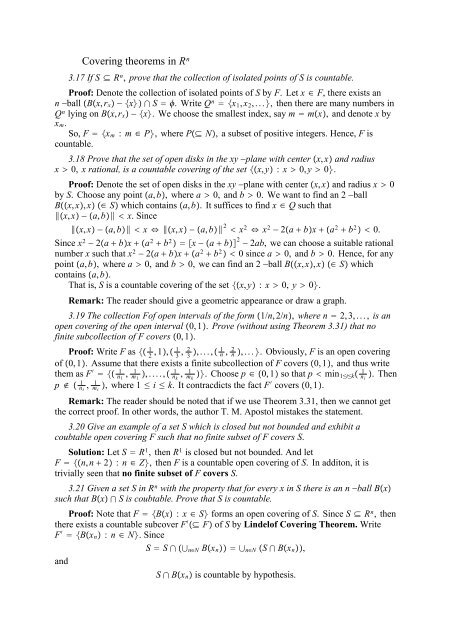The Real And Complex Number Systems
The Real And Complex Number Systems
The Real And Complex Number Systems
Create successful ePaper yourself
Turn your PDF publications into a flip-book with our unique Google optimized e-Paper software.
Covering theorems in R n<br />
3.17 If S R n , prove that the collection of isolated points of S is countable.<br />
Proof: Denote the collection of isolated points of S by F. Letx F, there exists an<br />
n ball Bx, r x x S . Write Q n x 1 , x 2 ,..., then there are many numbers in<br />
Q n lying on Bx, r x x. We choose the smallest index, say m mx, and denote x by<br />
x m .<br />
So, F x m : m P, whereP N, a subset of positive integers. Hence, F is<br />
countable.<br />
3.18 Prove that the set of open disks in the xy plane with center x, x and radius<br />
x 0, x rational, is a countable covering of the set x, y : x 0, y 0.<br />
Proof: Denote the set of open disks in the xy plane with center x, x and radius x 0<br />
by S. Choose any point a, b, wherea 0, and b 0. We want to find an 2 ball<br />
Bx, x, x S which contains a, b. It suffices to find x Q such that<br />
x, x a, b x. Since<br />
x, x a, b x x, x a, b 2 x 2 x 2 2a bx a 2 b 2 0.<br />
Since x 2 2a bx a 2 b 2 x a b 2 2ab, we can choose a suitable rational<br />
number x such that x 2 2a bx a 2 b 2 0sincea 0, and b 0. Hence, for any<br />
point a, b, wherea 0, and b 0, we can find an 2 ball Bx, x, x S which<br />
contains a, b.<br />
That is, S is a countable covering of the set x, y : x 0, y 0.<br />
Remark: <strong>The</strong> reader should give a geometric appearance or draw a graph.<br />
3.19 <strong>The</strong> collection Fof open intervals of the form 1/n,2/n, where n 2, 3, . . . , is an<br />
open covering of the open interval 0, 1. Prove (without using <strong>The</strong>orem 3.31) that no<br />
finite subcollection of F covers 0, 1.<br />
Proof: Write F as 1 ,1, 1 , 2 ,..., 1 2 3 3 n , 2 n ,.... Obviously, F is an open covering<br />
of 0, 1. Assume that there exists a finite subcollection of F covers 0, 1, and thus write<br />
them as F n 1 1<br />
1<br />
, m1 ,...., n 1 1<br />
k<br />
, mk . Choose p 0, 1 so that p min 1ik n 1 i<br />
. <strong>The</strong>n<br />
p n 1 1<br />
i<br />
, mi , where 1 i k. It contracdicts the fact F covers 0, 1.<br />
Remark: <strong>The</strong> reader should be noted that if we use <strong>The</strong>orem 3.31, then we cannot get<br />
the correct proof. In other words, the author T. M. Apostol mistakes the statement.<br />
3.20 Give an example of a set S which is closed but not bounded and exhibit a<br />
coubtable open covering F such that no finite subset of F covers S.<br />
Solution: Let S R 1 , then R 1 is closed but not bounded. <strong>And</strong> let<br />
F n, n 2 : n Z, then F is a countable open covering of S. In additon, it is<br />
trivially seen that no finite subset of F covers S.<br />
3.21 Given a set S in R n with the property that for every x in S there is an n ball Bx<br />
such that Bx S is coubtable. Prove that S is countable.<br />
Proof: Note that F Bx : x S forms an open covering of S. SinceS R n , then<br />
there exists a countable subcover F F of S by Lindelof Covering <strong>The</strong>orem. Write<br />
F Bx n : n N. Since<br />
S S nN Bx n nN S Bx n ,<br />
and<br />
S Bx n is countable by hypothesis.
















